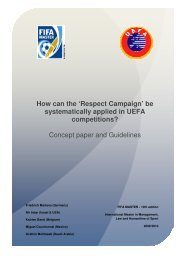Sports Marketing & Sponsorship - FIFA/CIES International University ...
Sports Marketing & Sponsorship - FIFA/CIES International University ...
Sports Marketing & Sponsorship - FIFA/CIES International University ...
- No tags were found...
You also want an ePaper? Increase the reach of your titles
YUMPU automatically turns print PDFs into web optimized ePapers that Google loves.
Stade Français Paris rugby clubWorld Cup victory and the ensuing celebrations. As amulti-purpose facility, it has also hosted numerousmajor shows such as operas and rock concerts, whichtend to reinforce the psychological association withentertainment and festivity.Apart from the aggressive price strategy, another keysuccess factor is the broad network of sales points.This includes retail outlets, such as multimedia storesthat appeal to younger demographic groups, andsupermarkets, which are strategic points to meetfamilial target groups. Moreover, tickets were offeredthrough websites that usually concentrated on nonsports-relatedevents.The fourth and final element, which SF Paris put agreat deal of effort into was promotion. The evidencesuggests that SF Paris, and particularly chairman MaxGuazzini, was determined to move the club from therestrictive world of rugby and give it a much broaderappeal as part of the overall entertainment sector. Forexample, club players were frequently invited toappear on non sports-related TV shows and the clublaunched several different musical ‘anthems’, whichwere broadcasted on radio stations.Another aspect of brand promotion concerns whatBourgeon and Bouchet (2001) define as the‘opportunist profile’. SF Paris certainly mirrored suchactivity through picking such celebrities as formermodel Naomi Campbell and Madonna as the club’sambassadors. The initiative increased brandawareness and enhanced the trendy, popular and‘show-biz’ aspects of the club. The club also worked todevelop other key public relationships, evidence ofwhich is the link the club implemented with the mayorof Paris.Finally, the advertising treatment was also verycreative, with adverts for special games having morein common with American blockbuster posters than aprofessional rugby game.All of the promotional communication channelstherefore focused on the spectacle and entertainmentaspects of the event and were designed to appeal tothe targeted segments.Comparative analysisA major difference between other French or, indeed,British rugby clubs is that SF Paris considered that thedemand, rugby was elastic and would growsignificantly as a result of a relevant marketingmanagement strategy. Until recently, clubs onlyconsidered the devoted or fanatical segments assuitable targets. Their strategy, in those cases whereplans have been made (Harris & Jenkins, 2001), isfocused on sporting success with the core being rugby.Such a strategy can increase customer loyalty andrevenues, which in turn helps to maintain the sportsbasedstrategy by further investing in high-qualityplayers.Morgan (2002) illustrated this model using theexample of Bath. Rugby union clubs try to recruit thebest players from around in the world, to offer astructured season with regular home games and tohave their international stars available in order tosatisfy investors. As far as the expectations ofspectators and television viewers are concerned, theprimary focus is on the uncertainly of the outcome,the significance of the game and the identificationwith the success (Morgan, 2002). We could arguethat the first and third such expectations arecontradictory, unless uncertainty concerns only theextent of the victory. This strategy is not wrong andhas been applied with success to numerous clubssuch as Leicester Tigers or Stade Toulousain (Fraioli,2005). It is certainly justified when clubs havesporting success and attract high attendances.However, there is a question as to whether thestrategy works for clubs that are not performing well,or if, when they do, they still fail to attract biggercrowds. We would argue that the strategy is notsuitable for such clubs.With regards to the commercial, marketing andbusiness strategic plan of rugby union, it appears thatthe Rugby Football Union (RFU), and English rugbyclubs by extension, tend to be positioned “towards upscalemen” (p.95), where “new participants are morelikely to be interested if they are introduced to thegame through a sympathetic third party and, as aCASE STUDY● APRIL 2009 ● <strong>International</strong> Journal of <strong>Sports</strong> <strong>Marketing</strong> & <strong>Sponsorship</strong>259
















